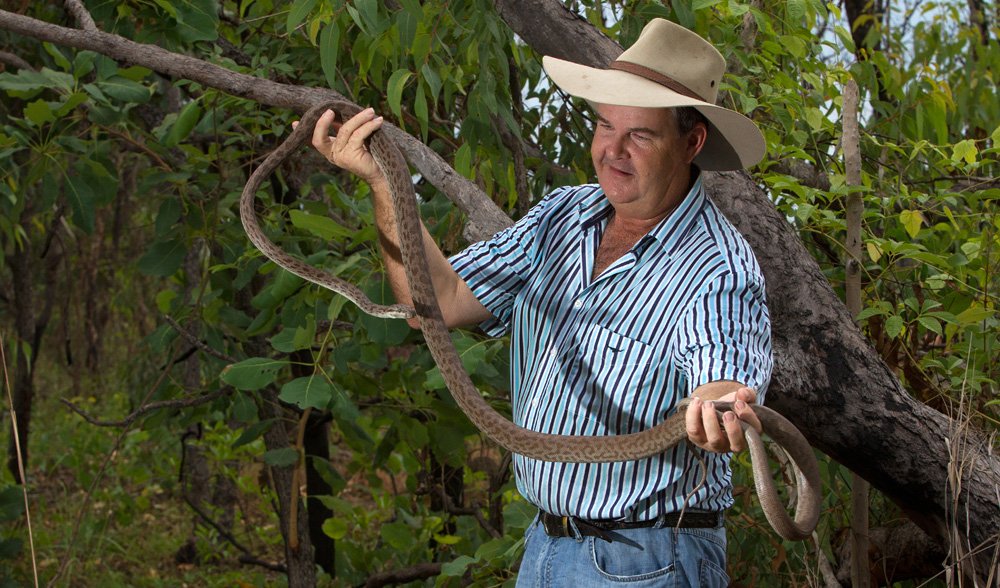Saving the Oenpelli python

AFTER INITIALLY fearing the rare Oenpelli python would go the way of the Tasmanian tiger, Top End herpetologist Gavin Bedford now thinks the animal may fight its way back from the brink of extinction with a little help from captive breeding.
Already a rare snake, the Oenpelli python has a limited home range in western Arnhem Land and is vunerable to widescale problems affecting the region.
Much hope for developing a safeguard rests with six snakes Gavin has captured in the last three years, in particular a large adult female more than 5m long.
A breeding pair of Oenpelli pythons, which some believe inspired the rainbow serpent of Aboriginal mythology, is valued at roughly $15,000 on the open market.
If any of the three pairs breed, their offspring will form the basis of a program where breeding the snakes is commercialised in an effort to make the program sustainable long-term.
“Parks and wildlife [officers] are monitoring the situation but no-one is doing anything,” Gavin says. “Extinction is the last thing you want and I believe that will happen if we don’t have any of these animals in captivity.”
Python at home amid rocks of Arnhem Land
The Oenpelli python (Morelia oenpelliensis) was first described by Europeans in 1977, but has long been recognised as an important totemic creature by the Bininj Aboriginal people of western Arnhem Land, particularly those living around the headwaters of the East Alligator River.
Its long and thin body can grow to at least 5m; it is dark olive brown with darkened blotches and an iridescent sheen that takes on an ethereal silver grey colour at night.
Secretive and shy, the big snake lives among sandstone outcrops in western Arnhem Land and sometimes ventures into the tropical woodland to hunt, often climbing into trees.
An ambush predator, it excels at remaining motionless for long periods waiting for prey such as rock rats, possums, bats and other mammals.

Gavin Bedford handling an Oenpelli python. (Credit: David Hancock)
Green light to breed Oenpelli pythons
In 2011, the Northern Territory government gave Gavin permission to collect eight pythons to establish a captive-breeding program.
“In my mind,” Gavin says, “captivity isn’t the ultimate solution, but it does have a part to play.”
“My aim is not to make a lot of money from this project, but to save the animal – the Oenpelli python is part of our heritage and sometimes it takes thinking outside the box to make things work.”
A wildlife researcher and former commercial snake breeder, Gavin’s concern is that studies of small mammals in the Top End show there is a wave of extinctions occurring. The Oenpelli python feeds exclusively on small mammals.
“We tend to believe governments protect and conserve our wildlife, but it appears that is not happening in the west Arnhem region, including Kakadu National Park, as there are no conservation plans for any animals recognised as being in dire trouble,” he says.
“I do not intend to sit by and watch this animal go extinct because of inaction, so I am putting my efforts into this project.”
Indigenous efforts to conserve the python
Aboriginal traditional owners of the region are also concerned about the future of Narwaran (as they know the animal), and some support the plan.
Gavin currently employs Aboriginal people and other locals around Garnbalunyah (formerly known as Oenpelli), a small community across the East Alligator River, east of Kakadu NP, to help him look for the pythons.
Through his program, traditional owners will also receive a royalty for every animal collected and a further royalty for offspring.
Each snake located will be fitted with a microchip and have its DNA registered. No adult Oenpelli pythons will be permitted to leave the Northern Territory.
“Only time will tell,” Gavin says. “But I wont give up on Nawaran. I hope others take up the challenge to ensure our grandchildren and beyond are lucky enough to see some of the amazing animals from this West Arnhem region.”




